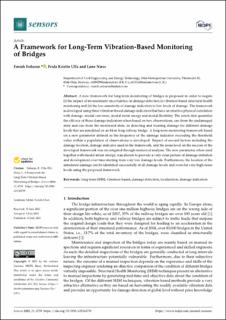| dc.contributor.author | Erduran, Emrah | |
| dc.contributor.author | Ulla, Frida Kristin | |
| dc.contributor.author | Næss, Lone | |
| dc.date.accessioned | 2022-03-17T12:17:05Z | |
| dc.date.available | 2022-03-17T12:17:05Z | |
| dc.date.created | 2022-01-31T20:51:43Z | |
| dc.date.issued | 2021-07-11 | |
| dc.identifier.issn | 1424-8220 | |
| dc.identifier.uri | https://hdl.handle.net/11250/2985839 | |
| dc.description.abstract | A new framework for long-term monitoring of bridges is proposed in order to negate (i) the impact of measurement uncertainties on damage detection in vibration-based structural health monitoring and (ii) the low sensitivity of damage indicators to low levels of damage. The framework is developed using three vibration-based damage indicators that have an intuitive physical correlation with damage: modal curvature, modal strain energy and modal flexibility. The article first quantifies the efficacy of these damage indicators when based on two observations, one from the undamaged state and one from the monitored state, in detecting and locating damage for different damage levels that are simulated on an 84-m long railway bridge. A long-term monitoring framework based on a new parameter defined as the frequency of the damage indicator exceeding the threshold value within a population of observations is developed. Impact of several factors including the damage location, damage indicator used in the framework, and the noise level on the success of the developed framework was investigated through numerical analysis. The new parameter, when used together with modal strain energy, was shown to provide a very clear picture of damage initiation and development over time starting from very low damage levels. Furthermore, the location of the simulated damage can be identified successfully at all damage levels and even for very high noise levels using the proposed framework. | en_US |
| dc.language.iso | eng | en_US |
| dc.publisher | MDPI | en_US |
| dc.relation.ispartofseries | Sensors;Volume 21 / Issue 14 | |
| dc.rights | Navngivelse 4.0 Internasjonal | * |
| dc.rights.uri | http://creativecommons.org/licenses/by/4.0/deed.no | * |
| dc.subject | Long-term structural health monitoring | en_US |
| dc.subject | Vibration-based monitoring | en_US |
| dc.subject | Damage detection | en_US |
| dc.subject | Localization | en_US |
| dc.subject | Damage indicators | en_US |
| dc.title | A Framework for Long-Term Vibration-Based Monitoring of Bridges | en_US |
| dc.type | Peer reviewed | en_US |
| dc.type | Journal article | en_US |
| dc.description.version | publishedVersion | en_US |
| dc.rights.holder | © 2021 by the authors | en_US |
| dc.source.articlenumber | 4739 | en_US |
| cristin.ispublished | true | |
| cristin.fulltext | original | |
| cristin.qualitycode | 1 | |
| dc.identifier.doi | https://doi.org/10.3390/s21144739 | |
| dc.identifier.cristin | 1995724 | |
| dc.source.journal | Sensors | en_US |
| dc.source.volume | 21 | en_US |
| dc.source.issue | 14 | en_US |
| dc.source.pagenumber | 1-22 | en_US |

